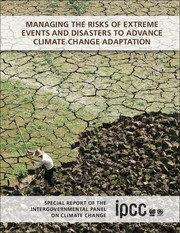 Managing the Risks of Extreme Events and Disasters to Advance Climate Change Adaptation
Managing the Risks of Extreme Events and Disasters to Advance Climate Change Adaptation Book contents
- Frontmatter
- Contents
- Section I
- Section II
- Section III
- Chapter 1 Climate Change: New Dimensions in Disaster Risk, Exposure, Vulnerability, and Resilience
- Chapter 2 Determinants of Risk: Exposure and Vulnerability
- Chapter 3 Changes in Climate Extremes and their Impacts on the Natural Physical Environment
- Chapter 4 Changes in Impacts of Climate Extremes: Human Systems and Ecosystems
- Chapter 5 Managing the Risks from Climate Extremes at the Local Level
- Chapter 6 National Systems for Managing the Risks from Climate Extremes and Disasters
- Chapter 7 Managing the Risks: International Level and Integration across Scales
- Chapter 8 Toward a Sustainable and Resilient Future
- Chapter 9 Case Studies
- Section IV
- Index
- References
Chapter 4 - Changes in Impacts of Climate Extremes: Human Systems and Ecosystems
from Section III
Published online by Cambridge University Press: 05 August 2012
- Frontmatter
- Contents
- Section I
- Section II
- Section III
- Chapter 1 Climate Change: New Dimensions in Disaster Risk, Exposure, Vulnerability, and Resilience
- Chapter 2 Determinants of Risk: Exposure and Vulnerability
- Chapter 3 Changes in Climate Extremes and their Impacts on the Natural Physical Environment
- Chapter 4 Changes in Impacts of Climate Extremes: Human Systems and Ecosystems
- Chapter 5 Managing the Risks from Climate Extremes at the Local Level
- Chapter 6 National Systems for Managing the Risks from Climate Extremes and Disasters
- Chapter 7 Managing the Risks: International Level and Integration across Scales
- Chapter 8 Toward a Sustainable and Resilient Future
- Chapter 9 Case Studies
- Section IV
- Index
- References
Summary
Executive Summary
Extreme impacts can result from extreme weather and climate events, but can also occur without extreme events. This chapter examines two broad categories of impacts on human and ecological systems, both of which are influenced by changes in climate, vulnerability, and exposure: first, the chapter primarily focuses on impacts that result from extreme weather and climate events, and second, it also considers extreme impacts that are triggered by less-than-extreme weather or climate events. These two categories of impacts are examined across sectors, systems, and regions. Extreme events can have positive as well as negative impacts on ecosystems and human activities.
Economic losses from weather- and climate-related disasters have increased, but with large spatial and interannual variability (high confidence, based on high agreement, medium evidence). Global weather- and climate-related disaster losses reported over the last few decades reflect mainly monetized direct damages to assets, and are unequally distributed. Estimates of annual losses have ranged since 1980 from a few US$ billion to above 200 billion (in 2010 dollars), with the highest value for 2005 (the year of Hurricane Katrina). In the period 2000 to 2008, Asia experienced the highest number of weather- and climate-related disasters. The Americas suffered the most economic loss, accounting for the highest proportion (54.6%) of total loss, followed by Asia (27.5%) and Europe (15.9%). Africa accounted for only 0.6% of global economic losses. Loss estimates are lower bound estimates because many impacts, such as loss of human lives, cultural heritage, and ecosystem services, are difficult to value and monetize, and thus they are poorly reflected in estimates of losses. [4.5.1, 4.5.3.3, 4.5.4.1]
- Type
- Chapter
- Information
- Managing the Risks of Extreme Events and Disasters to Advance Climate Change AdaptationSpecial Report of the Intergovernmental Panel on Climate Change, pp. 231 - 290Publisher: Cambridge University PressPrint publication year: 2012
References
- 107
- Cited by


